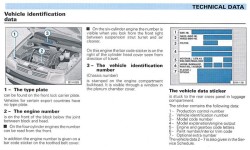VW VIN Codes
From 1965 onwards, Volkswagen used their own 9 or 10-digit chassis numbering system. It was useful for determining the VW model (digits 1 and 2) and the year model (digit 3), but in practical terms not much good for anything else. Other carmakers had also developed their own numbering systems, so there was no worldwide consistency.
After consultation with the world’s carmakers, a new ISO standard was introduced for 1980 and adopted by all makers. Rather than simply being a chassis number as before, the new 17-digit system would be able to uniquely identify every vehicle made by any carmaker in any part of the world. Volkswagen applied the new system for all of their vehicles made from 1 August 1979, the start of the 1980 model year. No VW made since then has had a ‘chassis number’ in the old sense. This is the system used today.
A typical Volkswagen VIN might be WVWZZZ3BZWE689725. All the characters in the string mean something. To understand the code, and be able to identify any Volkswagen made since 1980, we need to explain what the digits mean.
Modern VWs have the VIN located on a plate on the passenger-side of the dash at the base of the windscreen, visible from outside just near the wipers. It is also stamped in the engine bay, or under the dash or behind the seats. Consult your owners’ manual to find the exact location. In NSW there is also a copy of the VIN on your registration papers.
The VIN is split into three sections.
1. Digits 1-3: World Manufacturer Identifier
2. Digits 4-9: Vehicle Descriptor Section
3. Digits 10-17: Vehicle Identifier Section
World Manufacturer Identifier
The first three digits uniquely describe the manufacturer of the vehicle. There are many hundreds of assigned combinations.
Digit 1: Describes the region where the vehicle is made. A-H is in Africa, J-R is Asia, S-Z is Europe, 1-5 is North America, 6-7 is Oceania and 8-0 is South America.
Digit 2: Generally describes the manufacturer of the vehicle. For VW this is usually ‘V’, but sometimes not. It is assigned in conjunction with Digits 1 and 3, and may only make sense when the whole 3-digit WMI is considered.
Digit 3: Generally describes the vehicle type. This might be a passenger car, commercial, pickup, SUV, truck, motorcycle and so on.
For Volkswagens, the most common 3-digit WMIs you’ll see are:
WVW - Volkswagen Cars
WVG - Volkswagen SUVs (G for Gelande)
WV1 - Volkswagen Commercials
WV2 - Volkswagen Bus, Van
WV3 - Volkswagen Trucks
VWV - Volkswagen Spain
AAV - Volkswagen South Africa
1VW - Volkswagen USA (cars)
1V1 - Volkswagen USA (commercials)
3VW - Volkswagen Mexico
8AW - Volkswagen Argentina
9BW - Volkswagen Brazil
WAU - Audi
TRU - Audi Hungary
93V - Audi Brazil
Vehicle Descriptor Section
The next group of six digits (4 to 9) in the VIN describe the exact vehicle type, giving information on the model platform and body style. Each maker assigns their own meaning to these six digits. American makers, for example, use digit 9 as a ‘check digit’, but European makers such as VW do not.
In Volkswagen’s case, meaning is only given to digits 7 and 8. Digits 4, 5, 6 and 9 are fill-in digits only and will contain the letter ‘Z’.
Digit 4, 5 and 6: ZZZ for VWs sold in Europe and many other countries, including Australia. For USA-market VWs, these digits are used to give information on body and trim styles, engine specs and restraint systems.
Digit 7 and 8: Volkswagen’s Vehicle Descriptor Section. Many of them are consistent with VW’s old model type system, so you should spot some familiar numbers here. The most common Volkswagen combinations are:
11 - Beetle (Brazilian, Mexican, Nigerian)
13 - Scirocco 3
14 - Caddy 1 (European Golf 1 pickup)
15 - Cabriolet (1980 Beetle, Golf 1)
16 - Jetta 1 and 2 (early)
16 - Beetle (2012-on)
17 - Golf 1
18 - Iltis
19 - Golf 2 (early)
1C - New Beetle (US market)
1E - Golf 3 Cabriolet
1F - Eos
1G - Golf and Jetta 2 (late)
1H - Golf and Vento 3
1J - Golf and Bora 4
1K - Golf and Jetta 5, 6
1T - Touran
1Y - New Beetle Cabriolet
24 - T3 Transporter Single/Double Cab Pickup
25 - T3 Transporter Van, Kombi, Bus, Caravelle
28 - LT Transporter 1
2D - LT Transporter 2
2E - Crafter 1
2H - Amarok
2K - Caddy, Caddy Maxi 3
30 - Fox (US model ex-Brazil)
31 - Passat 2
32 - Santana sedan
33 - Passat 2 Variant
3A - Passat 3, 4
3B - Passat 5
3C - Passat 6, 7, 8, CC
3D - Phaeton
3H - Arteon
50 - Corrado (early)
53 - Scirocco 1, 2
5K - Golf and Jetta 6
5M - Golf Plus
5N - Tiguan 1, 2, Tiguan Allspace
5Z - Fox (Europe)
60 - Corrado (late)
6K - Polo Classic, Variant 3
6N - Polo 3
6R - Polo 5
6X - Lupo
70 - T4 Transporter Vans and Pickups
74 - Taro
7H - T5 Transporter, T6.1 Transporter
7J - T6 Transporter
7L - Touareg 1
7M - Sharan
7P - Touareg 2
86 - Polo and Derby 1 and 2
87 - Polo Coupe
9C - New Beetle
9K - Caddy 2 Van (ex-SEAT Ibiza)
9N - Polo 4
9U - Caddy 2 Pickup (ex-Skoda Felicia)
A1 - T-Roc
AA - Up!
AU - Golf 7
AW - Polo 6
C1 - T-Cross
CD - Golf 8
SK - Caddy 4
SY - Crafter 2
Digit 9: Z (fill-in digit) for Europe and most export markets, including Australia
Vehicle Identifier Section
The third and final set of digits, the group of eight from digit 10 to 17 inclusive, identifies the particular vehicle in question. They will identify the model year, the exact place where the car was made, and finally the unique serial number of that vehicle.
Digit 10: The model year. For Volkswagens, this is the year from 1 August to 31 July as before. The code begins with 1980, and assigns a consecutive letter or number for each year (except that I, O, Q, U, Z, and 0 are not used). The codes for year models are:
| 1980 - A | 1990 - L | 2000 - Y | 2010 - A | 2020 - L | 2030 - Y |
| 1981 - B | 1991 - M | 2001 - 1 | 2011 - B | 2021 - M | 2031 - 1 |
| 1982 - C | 1992 - N | 2002 - 2 | 2012 - C | 2022 - N | 2032 - 2 |
| 1983 - D | 1993 - P | 2003 - 3 | 2013 - D | 2023 - P | 2033 - 3 |
| 1984 - E | 1994 - R | 2004 - 4 | 2014 - E | 2024 - R | 2034 - 4 |
| 1985 - F | 1995 - S | 2005 - 5 | 2015 - F | 2025 - S | 2035 - 5 |
| 1986 - G | 1996 - T | 2006 - 6 | 2016 - G | 2026 - T | 2036 - 6 |
| 1987 - H | 1997 - V | 2007 - 7 | 2017 - H | 2027 - V | 2037 - 7 |
| 1988 - J | 1998 - W | 2008 - 8 | 2018 - J | 2028 - W | 2038 - 8 |
| 1989 - K | 1999 - X | 2009 - 9 | 2019 - K | 2029 - X | 2039 - 9 |
There are several logical consequences. There is no confusion between 1 and I, 2 or Z, or O, Q and 0. The characters repeat the sequence every 30 years, with ‘A’ beginning in 1980, 2010, 2040, etc. And, when the numbers begin after Y, the number coincides with the year.
Digit 11: This is the exact place where that Volkswagen was made. VW has tried to assign specific characters for each of its factories, although there have been some double-ups. If in doubt, consult Digit 1 which gives the region (see above). The factory codes are:
A - Ingolstadt, Germany
B - Brussels, Belgium
C - Chattanooga, USA
D - Bratislava, Slovakia
E - Emden, Germany
F - Ipiranga / Resende, Brazil
G - Graz, Austria
H - Hanover, Germany
K - Osnabrück, Germany
L - Lagos, Nigeria
M - Puebla, Mexico
N - Neckarsulm, Germany
P - Mosel, Germany
P - Anchieta, Brazil
R - Martorell, Spain
S - Salzgitter, Germany
T - Sarajevo, Yugoslavia (up to 1994)
T - Taubaté, Brazil
U - Uitenhage, South Africa
V - Westmoreland, USA (up to 1994)
V - Palmela, Portugal (from 1994)
W - Wolfsburg, Germany
X - Poznan, Poland
Y - Pamplona, Spain
1 - Győr, Hungary
2 - Anting, China
3 - Changchun, China
4 - Curitiba, Brazil
6 - Düsseldorf, Germany (Mercedes-Benz)
7 - Ludwigsfelde, Germany (Mercedes-Benz)
8 - Dresden, Germany
8 - General Pacheco, Argentina
9 - Wrzesnia, Poland
Digits 12-17: Six digits, starting with 000001 for each vehicle of the defined make, model, year and factory. This is the unique identifying number for that vehicle.
Start: 000001 Possible end: 999999

